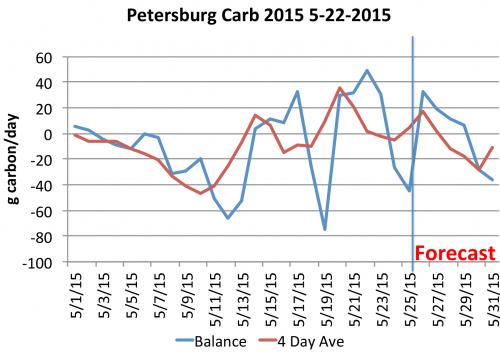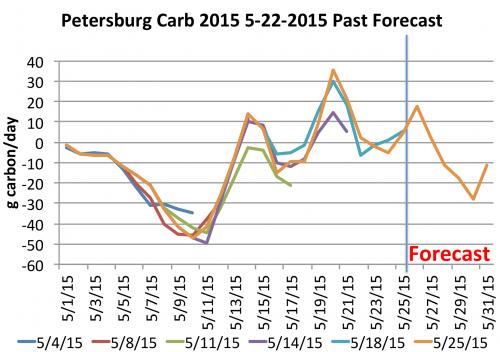Southeast Michigan fruit regional report – May 26, 2015
Apple crop load is mixed across the region; apple growers need to thoroughly assess crop load as we are in perfect crop stage and weather for thinning.
Weather
Cold temperatures last week and warmth over the weekend brought a mixed bag of weather, but overall our growth rate has slowed down. There was a chance of frost predicted two mornings last week, but no widespread frost was reported. However, there was light scattered frost reported Wednesday morning, May 20, and Saturday morning, May 30.
For much of eastern Michigan, our season has swung back again to currently running about normal for growing degree day (GDD) totals as well as growth stages, with the exception for strawberries which are several days to a week behind normal.
Soils across the region continue to run dry to very dry. A series of showers swept through the region Monday, Memorial Day, some with strong winds. Unfortunately, most fruit growers only received a few tenths of an inch of precipitation. Most areas of our region are running 2 to 4 inches behind normal for spring rainfall.
East Michigan GDD totals for March 1 to May 25, 2015 | |||
|---|---|---|---|
|
Location |
GDD42 |
GDD45 |
GDD50 |
|
Commerce (Oakland) |
677 |
545 |
361 |
|
Emmett (St Clair) |
638 |
511 |
337 |
|
Flint (Genesee) |
760 |
617 |
416 |
|
Lapeer (Lapeer) |
704 |
573 |
389 |
|
Petersburg (Monroe) |
752 |
610 |
413 |
|
Pigeon (Huron) |
547 |
433 |
281 |
|
Romeo (Macomb) |
701 |
568 |
378 |
Tree fruits
Apples are mostly 10 to 12 millimeters in size for king bloom, with side bloom running about 2 millimeters less in size. In visits I made late last week to apple growers in the southern tier of counties, apple size was just about the same across the entire region; this is unusual in that most seasons apples in the far south are 5 to 7 millimeters ahead of the rest of the region.
Apple crop load is mixed to extremely variable across the region this season. Most blocks had great bloom, but I believe we did not have good bee activity and poor weather during bloom. Most blocks had a tremendous amount of drop in the past week. Thus, apple thinning decisions are very difficult to make this season. A few growers are at the other end of the thinning spectrum, needing to aggressively thin most of their varieties. With warmer temperatures forecast for next four days and fruitlet size mostly under 15 millimeters, we are entering an excellent time to apply thinners. The carbohydrate thinning model and charts suggest that trees will not be under stress for this period, so Michigan State University Extension recommends using normal rates and good thinning should occur. In blocks where aggressive thinning needs to occur, use aggressive or higher rates.

The Cornell Carbohydrate Thinning Model for southeast Michigan as of May 22, 2015 in Petersburg, Michigan.

Summary of all the carbohydrate thinning models for the 2015 season in Petersburg, Michigan.
Apple scab lesions continue to show up in a few apple blocks, mostly from the April 5 and 10 infection periods. The number of spores released in yesterday’s rain is on the decline, but it was hard to read the spore rods due to the amount of debris on the rods caused by high winds, and we only had 0.18 inch of rain at the trapping location. According to the Enviro-weather apple scab model, we are at 100 percent of spores being mature. However, remember that once they are mature, we still need wetting events to be released. So, we are still in primary apple scab season.
I have not found any fire blight strikes, nor have I seen any oozing from last season’s cankers. With yesterday’s strong winds, young tender new growth and some rag tag bloom in most apple blocks, I am concerned about fire blight infection again.
Plum curculio is being found in apples and other tree fruits and in ground covers, but I have not seen any oviposition scars. This week, I expect to see an increase in plum curculio activity. Codling moth trap catch continues to quickly climb, mostly in non-mating disruption blocks. Many growers biofixed for codling moth May 19 or 20. A few potato leafhopper adults are just starting to be found. Rosy apple aphids and apple grain aphids are also just starting to be seen in very low numbers, however. Tarnished plant bugs are starting to be seen in a few apple blocks.
A few apple blocks continue to have very high numbers of leafrollers, but have been controlled with petal fall sprays. These were mostly a problem where pink sprays were not applied. Oriental fruit moth trap catch is now on the decline. European red mite egg hatch continues, as are a few rust mites. Oystershell scale crawlers continue in the crawler stage. San Jose scale adult males continue to be caught in traps in high numbers. Mullein plant bug adults continue to be found, but now are considered a beneficial insect. Many beneficial insects are being seen.
Pears are 11 to 12 millimeters size with a fair amount of drop this past week. The crop load appears extremely variable this season. All stages of pear psylla continue to be seen this week.
Peaches are at late shuck split to 9 to 12 millimeters for those few growers with a crop this season. Growers continue to remove dead and dying trees; most of these blocks are older trees. Tarnished plant bugs are being found in low numbers. Peach leaf curl continues to be seen.
Sweet cherries are 11 to 14 millimeters in size. Most varieties have thinned down to one to three fruit per cluster. They are not pit hardening yet.
Tart cherries are 9 to 11 millimeters in size. There was a good amount of fruit drop in tart cherries in the last week. Earlier this season it appeared we had a good crop of tart cherries coming along.
European plums are 8 to 9 millimeters and Japanese plums are 3 to 9 millimeters. Some Japanese plum varieties have little to no crop this season.
Small fruits
Grapes shoots are 8 to 12 inches in length for Concord types with flower buds continuing to elongate. Many European varieties have extensive winter kill.
Strawberries are at full bloom and continue to look much better every week. It appears the start of strawberry harvest will be several days to a week later than normal. Strawberry clipper feeding damage continues at many farms, especially where cover sprays were not applied. Gray mold cover sprays are being applied this week.
Raspberry flower buds are just starting to open on summer fruiting varieties. Dead cane tips continue to be seen in several varieties of summer fruiting raspberries. Fall red raspberry canes continue to put on good new growth, now the longest canes are 12 to 15 inches in length.
Blueberries have been at full bloom for most varieties, and petal fall to early green fruit for early fruiting varieties. More time is needed to determine crop load for this season.



 Print
Print Email
Email


